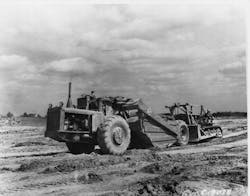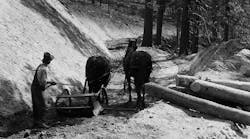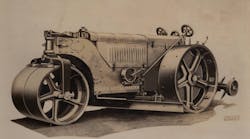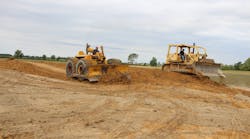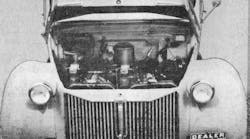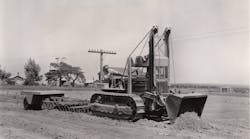Euclid Road Machinery Co. built several very distinctive prototype and experimental overhung motor scrapers between 1939 and 1952 before settling on a standard, practical design. The original designs featured rigid-frame construction between the tractor and scraper, with steering provided by the scraper’s rear wheels. This one, the 28FDT tractor and 18-yard 9SH scraper, was built in 1945 and uses conventional hydraulic steering, pivoting between the prime mover and scraper; but the steering system’s developmental costs led the company to shelve the idea and focus on two-axle tractors until 1954. The later machines continued the 28FDT’s use of hydraulics, and the operator’s station was much more conventionally—and conveniently—situated than on the 28FDT.
Euclid continued the model nomenclature used here, with the tractor and scraper having separate model designations; but the 1954 product line also introduced the practice of the combined tractor and scraper having its own S, SS or TS series designation. For instance, an S-18 scraper could consist of a 27LOT or 30LOT prime mover, with different transmissions and other mechanical features, and a 28SH or 31SH scraper of differing capacities. But if a single-axle prime mover was used with an end- or bottom-dump wagon, the combination used the prime mover’s S or TS series designation; and if a two-axle SS-series tractor was pulling a bottom dump wagon, the combination was identified by the separate model numbers of the tractor and wagon until a uniform B-series prefix came into use for these machines in the early 1960s.
The Euclid scraper line was retained by General Motors when it was forced to spin off the Euclid truck line in 1968, and the TS14G scraper built by Terex traces its roots to the Euclid line.
--This article was submitted by Tom Berry, archivist of the Historical Construction Equipment Association (HCEA). With more than 4,300 members in 25 countries, activities include operation of National Construction Equipment Museum and archives in Bowling Green, Ohio; publication of a quarterly magazine, Equipment Echoes; and hosting an annual working exhibition of restored construction equipment. Individual memberships are $30 for USA/Canada, and $40 elsewhere. For more information, 419.352.5616 or [email protected].
